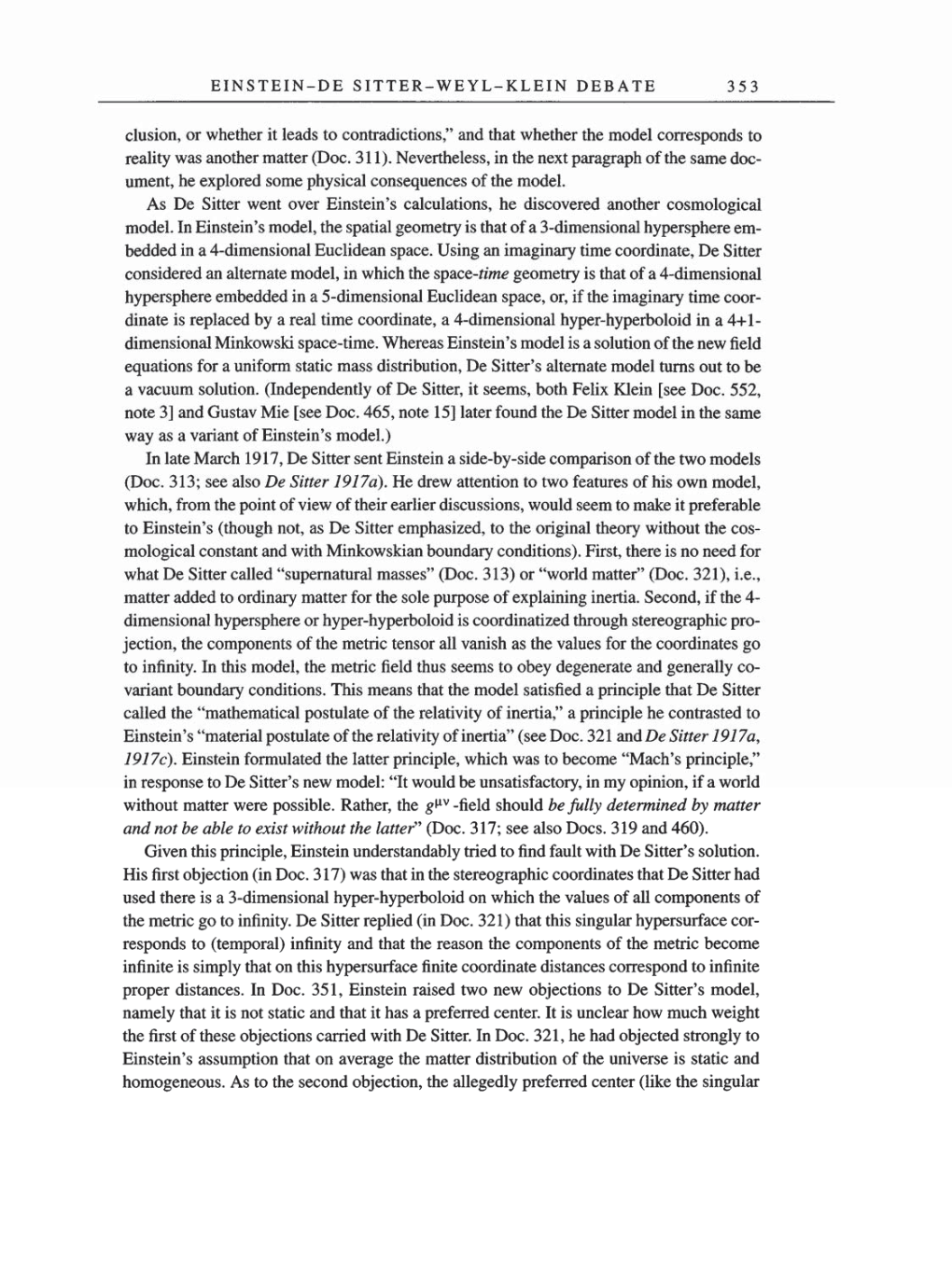EINSTEIN-DE SITTER-WEYL-KLEIN DEBATE 353
clusion,
or
whether it leads to
contradictions,”
and
that whether
the model
corresponds
to
reality
was
another matter
(Doc. 311).
Nevertheless,
in the next
paragraph
of
the
same
doc-
ument,
he
explored some
physical
consequences
of
the model.
As
De Sitter went
over
Einstein’s
calculations,
he
discovered another
cosmological
model. In Einstein’s
model,
the
spatial geometry
is that
of
a
3-dimensional
hypersphere
em-
bedded in
a
4-dimensional Euclidean
space. Using
an imaginary
time
coordinate,
De Sitter
considered
an
alternate
model,
in which the
space-time geometry
is that
of
a
4-dimensional
hypersphere
embedded in
a
5-dimensional Euclidean
space,
or,
if
the
imaginary
time
coor-
dinate is
replaced by a
real
time
coordinate,
a
4-dimensional
hyper-hyperboloid
in
a
4+1-
dimensional Minkowski
space-time.
Whereas Einstein’s model is
a
solution
of
the
new
field
equations
for
a
uniform static
mass
distribution,
De Sitter’s alternate model turns
out to be
a
vacuum
solution.
(Independently
of
De
Sitter,
it
seems,
both Felix Klein
[see
Doc.
552,
note
3]
and Gustav Mie
[see
Doc.
465,
note
15]
later found the
De Sitter model in the
same
way as a
variant
of
Einstein’s
model.)
In
late March
1917,
De Sitter sent Einstein
a side-by-side comparison
of
the
two models
(Doc.
313;
see
also De
Sitter
1917a).
He drew attention to two features
of
his
own
model,
which,
from the
point
of
view
of
their earlier
discussions,
would
seem
to make it
preferable
to Einstein’s
(though
not,
as
De
Sitter
emphasized,
to the
original theory
without
the
cos-
mological
constant and with Minkowskian
boundary conditions).
First,
there
is
no
need for
what De Sitter called
“supernatural
masses”
(Doc. 313) or
“world matter”
(Doc. 321), i.e.,
matter added to
ordinary
matter for the sole
purpose
of
explaining
inertia.
Second,
if
the 4-
dimensional
hypersphere
or hyper-hyperboloid
is
coordinatized
through stereographic pro-
jection,
the
components
of
the metric tensor all vanish
as
the
values for the coordinates
go
to
infinity.
In this
model,
the metric field thus
seems
to
obey degenerate
and
generally co-
variant
boundary
conditions. This
means
that the model satisfied
a principle
that
De Sitter
called the “mathematical
postulate
of
the
relativity
of
inertia,”
a principle
he
contrasted
to
Einstein’s “material
postulate
of
the
relativity
of
inertia”
(see
Doc. 321 and De Sitter
1917a,
1917c).
Einstein formulated
the latter
principle,
which
was
to become “Mach’s
principle,”
in
response
to De Sitter’s
new
model: “It would be
unsatisfactory,
in
my opinion,
if
a
world
without
matter
were possible. Rather,
the guv -field should be
fully
determined
by
matter
and
not be
able
to
exist without the
latter”
(Doc. 317; see
also Docs. 319 and
460).
Given this
principle,
Einstein
understandably
tried to find fault with De Sitter’s solution.
His first
objection
(in
Doc.
317) was
that
in
the
stereographic
coordinates that De
Sitter
had
used there is
a
3-dimensional
hyper-hyperboloid
on
which the values
of
all
components
of
the metric
go
to
infinity.
De
Sitter
replied
(in
Doc.
321)
that this
singular hypersurface
cor-
responds
to
(temporal) infinity
and that the
reason
the
components
of
the metric
become
infinite is
simply
that
on
this
hypersurface
finite
coordinate
distances
correspond
to infinite
proper
distances. In Doc.
351,
Einstein raised two
new objections
to De Sitter’s
model,
namely
that it is not static and
that
it has
a preferred
center. It is
unclear
how
much
weight
the first
of
these
objections
carried
with De Sitter. In Doc.
321,
he had
objected strongly
to
Einstein’s
assumption
that
on average
the matter distribution
of
the universe is static and
homogeneous.
As to the second
objection,
the
allegedly
preferred
center
(like
the
singular
